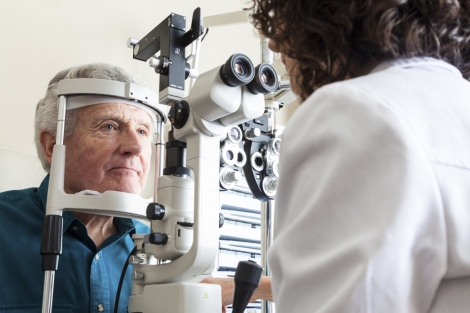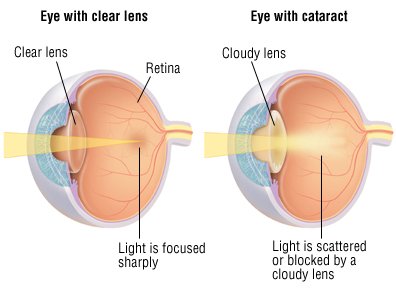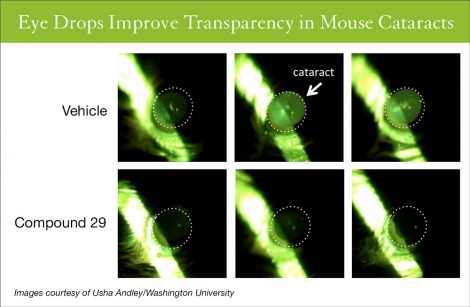Eye-drops to Clear Cataracts
University of California San Francisco (UCSF) is reporting a remarkable breakthrough in the potential treatment of cataracts. A chemical Sterol termed Compound 29 has been shown to dissolve and repair cataracts. Further still, Compound 29 can be applied like an ordinary eye drop and does not require any form of injection such as previous sterols like lanosterol that showed similar promise.
( A newly identified compound is the first that is soluble enough to potentially form the basis of a practical eye-drop medication for cataracts.)
A chemical that could potentially be used in eye drops to reverse cataracts, the leading cause of blindness, has been identified by a team of scientists from UC San Francisco (UCSF), the University of Michigan (U-M), and Washington University in St. Louis (WUSTL).
Identified as a "priority eye disease" by the World Health Organization, cataracts — caused when the lenses of the eyes lose their transparency — affect more than 20 million people worldwide. Although cataracts can be successfully removed with surgery, this approach is expensive, and most individuals blinded by severe cataracts in developing countries go untreated.
Reported Nov. 5 in Science, the newly identified compound is the first that is soluble enough to potentially form the basis of a practical eye-drop medication for cataracts.
Cataracts are primarily a disease of aging. As is seen in neurodegenerative conditions such as Alzheimer's disease and Parkinson's disease, a hallmark of the condition is the misfolding and clumping together of crucial proteins. In the case of cataracts, the affected proteins are known as crystallins.
Crystallins are the major component of fiber cells, which form the eyes' lenses, and the unique properties of these cells make them particularly susceptible to damage, said Jason Gestwicki, PhD, associate professor of pharmaceutical chemistry at UCSF and co-senior author of a paper on the new research, most of which was undertaken in Gestwicki's laboratory at the U-M Life Sciences Institute.
"Shortly after you're born, all the fiber cells in the eye lose the ability to make new proteins, or to discard old proteins," said Gestwicki, who has continued his work on cataracts at UCSF, where he joined the faculty about two years ago. "So the crystallins you have in your eye as an adult are the same as those you're born with."
In order for our lenses to function well, this permanent, finite reservoir of crystallins must maintain both the transparency of fiber cells and their flexibility, as the eyes' muscles constantly stretch and relax the lens to allow us to focus on objects at different distances.
The crystallins accomplish these duties with the help of aptly named proteins known as chaperones, which act "kind of like antifreeze," Gestwicki said, "keeping crystallins soluble in a delicate equilibrium that's in place for decades and decades."
This state-of-affairs is "delicate" because pathological, clumped-together configurations of crystallins are far more stable than properly folded, healthy forms, and fiber-cell chaperones must continually resist the strong tendency of crystallins to clump. A similar process underlies other disorders related to aging, such as Alzheimer's disease, but in each of these diseases the specific protein that clumps together and the place in the body that clumping occurs is different. In all cases, these clumped-together proteins are called amyloids.
Lowering the Melting Point of Amyloids
In the new study, led by Leah N. Makley, PhD, and Kathryn McMenimen, PhD, the scientific team exploited a crucial difference between properly folded crystallins and their amyloid forms: put simply, amyloids are harder to melt.
The research group used a method known as high-throughput differential scanning fluorimetry, or HT-DSF, in which proteins emit light when they reach their melting point. At the U-M Life Sciences Institute's Center for Chemical Genomics, the team used HT-DSF to apply heat to amyloids while applying thousands of chemical compounds.
Because the melting point of amyloids is higher than that of normal crystallins, the team focused on finding chemicals that lowered the melting point of crystallin amyloids to the normal, healthy range.
The group began with 2,450 compounds, eventually zeroing in on 12 that are members of a chemical class known as sterols. One of these, known as lanosterol, was shown to reverse cataracts in a July paper in Nature, but because lanosterol has limited solubility, the group who published that study had to inject the compound into the eye for it to exert its effects. Using lanosterol and other sterols as a clue, Gestwicki and his group assembled and tested 32 additional sterols, and eventually settled on one, which they call "compound 29," as the most likely candidate that would be sufficiently soluble to be used in cataract-dissolving eye drops.
In laboratory dish tests, the team confirmed that compound 29 significantly stabilized crystallins and prevented them from forming amyloids. They also found that compound 29 dissolved amyloids that had already formed. Through these experiments, said Gestwicki, "we are starting to understand the mechanism in detail. We know where compound 29 binds, and we are beginning to know exactly what it's doing."
(Mice, aged 5 weeks, were treated three times per week for six weeks with "compound 29" in the right eye and a vehicle control in the left eye. At the end of the experiment, mice were examined by slit lamp biomicroscopy, which showed improved transparency. Dotted white lines highlight the edges of the eye.)
Follow this link to continue reading the source article: https://www.ucsf.edu/news/2015...
View the research paper here: http://www.sciencemag.org/cont...
This sounds to me like resoundingly good news for humanity. The previous option of corrective lens surgery was carried risks that this new method appears to avoid. I feel a little safer aging knowing that this treatment is in development.
Posted by: krishnamurthy_gr@yahoo.co.in
| Reply via web post | • | Reply to sender | • | Reply to group | • | Start a New Topic | • | Messages in this topic (1) |





No comments:
Post a Comment